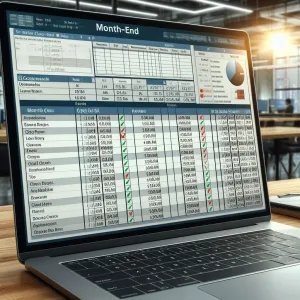Quality assurance reviews (QARs) are essential evaluations that assess the effectiveness and compliance of internal audit functions with established standards. These reviews serve as a systematic approach to ensure that internal audit activities are conducted with professionalism and integrity, aligning with the International Standards for the Professional Practice of Internal Auditing set by the Institute of Internal Auditors (IIA) [2][13].
In today’s business environment, the importance of stakeholder trust cannot be overstated. Stakeholders, including management, board members, and external parties, increasingly rely on the internal audit function to provide assurance that organizational processes are effective and compliant with regulations. As organizations face complex challenges and heightened scrutiny, the credibility of internal audits becomes paramount. Quality assurance reviews play a critical role in building this trust by demonstrating that audits are not only thorough but also adhere to high-quality standards [5][6].
The contribution of quality assurance reviews to enhancing stakeholder trust is multifaceted:
- Assessment of Compliance: QARs evaluate whether internal audit activities conform to the defined standards and ethical guidelines, ensuring that stakeholders can rely on the findings and recommendations provided by auditors [4][10].
- Identification of Improvement Areas: Through a comprehensive evaluation, QARs identify strengths and weaknesses within the internal audit function, allowing for continuous improvement. This proactive approach reassures stakeholders that the audit process is dynamic and responsive to changing needs [12][14].
- Enhanced Communication: Quality assurance reviews facilitate better communication between auditors and stakeholders. By providing clear insights into the audit process and outcomes, stakeholders gain a deeper understanding of the value added by internal audits, fostering a culture of transparency and accountability [3][11].
Quality assurance reviews are a vital component of the internal audit process, serving to enhance stakeholder trust through rigorous evaluation, continuous improvement, and effective communication. As organizations strive for excellence in governance and risk management, the role of QARs in reinforcing the credibility of internal audits will only continue to grow.
The Importance of Quality Assurance Reviews
Quality assurance (QA) reviews play a pivotal role in the internal audit process, significantly impacting the effectiveness and reliability of audit findings. By implementing robust QA processes, organizations can enhance their credibility with stakeholders, fostering trust and confidence in the audit outcomes. Here are some key points that highlight the importance of quality assurance reviews in internal audits:
- Impact on Effectiveness and Reliability of Audit Findings: Quality assurance reviews ensure that audit processes comply with established standards and maintain a high level of quality. This adherence to standards not only enhances the reliability of the findings but also provides objective insights that are crucial for informed decision-making. When stakeholders can trust the accuracy of the audit results, it reinforces the overall integrity of the audit function [7][5].
- Identifying Areas for Improvement: QA reviews serve as a mechanism for internal assessment, allowing auditors to identify areas where the audit process can be improved. By regularly evaluating the effectiveness of audit methodologies and practices, organizations can implement constructive suggestions that lead to enhanced operational efficiency. This continuous improvement cycle is vital for adapting to changing regulations and stakeholder expectations [1][3].
- Relationship Between High-Quality Audits and Stakeholder Confidence: There is a direct correlation between the quality of audits and the confidence stakeholders place in the audit process. High-quality audits, supported by thorough QA reviews, demonstrate a commitment to transparency and accountability. This, in turn, cultivates a sense of trust among stakeholders, as they can be assured that the audit findings are credible and reflective of the organization’s true state [2][4].
Quality assurance reviews are not merely a procedural formality; they are essential for building and maintaining credibility with audit stakeholders. By ensuring that audits are conducted with the highest standards of quality, organizations can enhance stakeholder trust and confidence, ultimately leading to more effective governance and risk management.
Key Components of Effective Quality Assurance Processes
Quality assurance (QA) reviews are essential for enhancing stakeholder trust in internal audit functions. By adhering to established standards and guidelines, maintaining independence and objectivity, and ensuring thorough documentation, internal auditors can significantly improve the credibility of their audit processes. Below are the critical elements that contribute to successful quality assurance reviews.
1. Standards and Guidelines
Effective quality assurance processes in internal audits are guided by several key standards and frameworks:
- International Professional Practices Framework (IPPF): Developed by the Institute of Internal Auditors (IIA), the IPPF outlines the essential principles and standards for internal auditing. It emphasizes the need for quality assurance and improvement programs (QAIP) to ensure that audit activities meet professional standards and deliver value to the organization [1][11].
- ISO Standards: The ISO 9001 standard, which focuses on quality management systems, provides a framework for organizations to ensure consistent quality in their processes. Internal audits aligned with ISO standards help assess compliance with established quality benchmarks and drive continuous improvement [4][8].
These standards not only provide a roadmap for conducting quality assurance reviews but also help in establishing a common language and expectations among stakeholders.
2. Independence and Objectivity
Independence and objectivity are cornerstones of effective quality assurance reviews. Internal auditors must maintain an unbiased perspective to ensure that their assessments are credible and trustworthy. This involves:
- Separation of Duties: Ensuring that the individuals conducting the QA reviews are not involved in the activities being audited. This separation helps to eliminate conflicts of interest and enhances the integrity of the review process [2].
- Impartial Evaluation: QA reviews should be conducted without any influence from management or other stakeholders. This impartiality is crucial for providing stakeholders with confidence in the findings and recommendations of the audit [11].
By prioritizing independence and objectivity, internal auditors can foster a culture of transparency and accountability, which is vital for building stakeholder trust.
3. Documentation and Evidence
Thorough documentation and the collection of evidence are critical components of the QA process. They serve multiple purposes:
- Supporting Findings: Documentation provides the necessary support for audit conclusions and recommendations. It ensures that the audit process is transparent and that stakeholders can review the basis for the findings [10][11].
- Facilitating Continuous Improvement: By maintaining detailed records of the QA process, internal auditors can identify trends, areas for improvement, and best practices over time. This ongoing evaluation is essential for enhancing the effectiveness of the internal audit function [13][14].
- Compliance and Accountability: Proper documentation ensures compliance with established standards and guidelines, and it holds auditors accountable for their work. This accountability is crucial for maintaining stakeholder confidence in the audit process [15].
Effective quality assurance reviews are vital for enhancing audit stakeholder trust. By adhering to established standards, maintaining independence and objectivity, and ensuring thorough documentation, internal auditors can build credibility and demonstrate their commitment to delivering high-quality audit services.
Implementing Quality Assurance Reviews
Quality assurance reviews (QARs) are essential for internal auditors aiming to enhance stakeholder trust and credibility. By establishing a robust QA framework, auditors can ensure their processes meet professional standards and stakeholder expectations. Here are practical steps to implement effective quality assurance reviews:
Steps to Develop a Quality Assurance Review Framework
- Initial Audit Planning: Begin by defining the scope and objectives of the QA review. This involves identifying the key areas of focus, such as compliance with standards and the effectiveness of audit processes [2].
- Engage Subject Matter Experts: Involve risk and process experts to provide insights into the audit processes. Their expertise can help identify potential gaps and areas for improvement.
- Establish QAIP Components: Develop a comprehensive Quality Assurance and Improvement Program (QAIP) that includes ongoing monitoring and periodic self-assessments. This framework should align with the International Professional Practices Framework (IPPF) to ensure adherence to established standards [1][11].
- Utilize Checklists and Automation Tools: Implement checklists or automation tools to ensure compliance with established practices and to maintain consistency in applying performance standards. This can streamline the QA process and enhance efficiency [13].
Training and Skill Development in QA Methodologies
To effectively implement QA reviews, internal auditors must be equipped with the necessary skills and knowledge. This can be achieved through:
- Training Programs: Regular training sessions on QA methodologies and best practices are crucial. These programs should cover the latest trends in internal auditing and quality assurance to keep auditors updated [12].
- Professional Development: Encourage auditors to pursue certifications and professional development opportunities that focus on quality assurance. This not only enhances their skills but also builds credibility within the organization [10].
Establishing a Feedback Loop for Continuous Improvement
Creating a feedback loop is vital for the continuous enhancement of the QA process. This can be achieved through:
- Stakeholder Feedback: Actively seek feedback from stakeholders regarding the audit processes and communication methods. This input can provide valuable insights into areas that require improvement [6].
- Regular Reviews and Adjustments: Conduct regular reviews of the QA processes based on stakeholder feedback and audit outcomes. This iterative approach allows for timely adjustments and ensures that the QA framework remains effective and relevant [3].
- Documentation of Best Practices: Document successful QA practices and lessons learned to share with the audit team and stakeholders. This not only fosters a culture of continuous improvement but also enhances the overall quality of the internal audit function [4].
By implementing these steps, internal auditors can build a strong quality assurance review framework that enhances stakeholder trust and credibility, ultimately leading to a more effective audit function.
Measuring the Impact of Quality Assurance Reviews
Quality Assurance (QA) reviews play a pivotal role in the internal audit function, significantly influencing stakeholder trust and confidence. By implementing effective QA processes, organizations can enhance their credibility and ensure that audit activities are conducted to the highest standards. This section will delve into methods for evaluating the effectiveness of QA processes and their contribution to building stakeholder trust.
Key Performance Indicators (KPIs) for Assessing QA Review Outcomes
To effectively measure the impact of QA reviews, organizations should establish clear Key Performance Indicators (KPIs). These KPIs can provide quantifiable metrics that reflect the quality and effectiveness of the internal audit function. Some essential KPIs include:
- Audit Completion Rates: Tracking the percentage of audits completed on time can indicate the efficiency of the audit process.
- Compliance with Standards: Measuring adherence to established auditing standards and frameworks helps assess the quality of the audit work.
- Stakeholder Satisfaction Scores: Gathering feedback from stakeholders regarding their satisfaction with audit outcomes can provide insights into the perceived value of the audit function.
- Follow-up Action Rates: Monitoring the implementation of recommendations from audits can demonstrate the effectiveness of the audit in driving improvements within the organization.
These KPIs not only help in evaluating the QA review outcomes but also serve as a basis for continuous improvement in the internal audit processes [1][6].
Importance of Stakeholder Feedback in Measuring Trust and Confidence
Stakeholder feedback is crucial in assessing the effectiveness of QA reviews and the overall trust in the internal audit function. Engaging stakeholders through surveys, interviews, and feedback sessions can provide valuable insights into their perceptions of the audit process. Key aspects to consider include:
- Transparency: Stakeholders appreciate transparency in the audit process, which can be fostered through open communication about QA review findings and actions taken.
- Responsiveness: Demonstrating a willingness to address stakeholder concerns and incorporate their feedback into the audit process can significantly enhance trust.
- Perceived Value: Understanding how stakeholders perceive the value of the audit function can help auditors align their objectives with stakeholder expectations, thereby building confidence in the audit outcomes [4][10].
Measuring the impact of quality assurance reviews through KPIs, stakeholder feedback, and real-world case studies is essential for internal auditors aiming to build trust and credibility. By focusing on these areas, organizations can ensure that their audit processes not only meet established standards but also foster strong relationships with stakeholders.
Challenges in Quality Assurance Reviews
Quality assurance (QA) reviews are essential for internal auditors to enhance stakeholder trust and credibility. However, several challenges can impede the effectiveness of these reviews. Below are some common challenges faced by internal auditors during QA reviews, along with suggested solutions.
1. Resistance to Change
One of the most significant challenges in conducting QA reviews is the resistance to change from employees and management. Audits can often be perceived as a threat or an unnecessary burden, leading to pushback against the review processes.
Solutions:
- Communication and Education: It is crucial to communicate the benefits of QA reviews clearly. Educating stakeholders about how these reviews can lead to improved processes and risk management can help mitigate resistance.
- Involvement of Stakeholders: Engaging employees in the QA process can foster a sense of ownership and reduce resistance. Involving them in discussions about the audit process and its benefits can lead to a more collaborative environment [3][4].
2. Resource Constraints
Limited resources, including budgetary constraints and staffing shortages, pose a significant challenge for internal audit teams. These limitations can hinder the ability to conduct thorough QA reviews and implement necessary improvements.
Solutions:
- Prioritization of Audit Activities: Internal auditors should prioritize their QA activities based on risk assessments and organizational needs. Focusing on high-risk areas can ensure that limited resources are utilized effectively.
- Leveraging Technology: Utilizing audit management software and tools can streamline the QA process, reduce manual tasks, and enhance efficiency. This can help auditors maximize their output even with constrained resources [8][10].
3. Maintaining Objectivity
Maintaining independence and objectivity is critical for internal auditors, especially amid organizational pressures. Internal auditors may face challenges in remaining impartial due to relationships with management or the organizational culture.
Solutions:
- Establishing Clear Protocols: Developing and adhering to clear protocols and standards for conducting QA reviews can help auditors maintain objectivity. This includes defining roles and responsibilities to minimize conflicts of interest.
- Regular Training and Development: Continuous professional development and training can reinforce the importance of objectivity and independence in the audit process. Encouraging auditors to engage in discussions about ethical dilemmas can also strengthen their commitment to impartiality [6][9].
By addressing these challenges through effective strategies, internal auditors can enhance the quality of their reviews, thereby building credibility and trust with stakeholders. Quality assurance reviews not only improve audit processes but also contribute to a culture of transparency and accountability within organizations.
Future Trends in Quality Assurance for Internal Audit
Quality assurance (QA) reviews play a pivotal role in enhancing stakeholder trust within the internal audit function. As the landscape of auditing evolves, several trends and innovations are emerging that can significantly impact QA processes. Here are some key points to consider:
1. Impact of Technology on Quality Assurance Processes
The integration of advanced technologies such as Artificial Intelligence (AI) and data analytics is transforming quality assurance in internal audits. These tools enable auditors to:
- Analyze Vast Datasets: Technologies like ACL Analytics, IDEA, and Power BI allow auditors to efficiently sift through large volumes of data, identifying anomalies and trends that may not be visible through traditional methods [3].
- Enhance Audit Quality: The use of AI and machine learning (ML) can lead to more comprehensive audits by automating routine tasks and providing deeper insights into risk areas [7]. This not only improves the accuracy of audits but also builds credibility with stakeholders who expect thorough and reliable assessments.
2. Shift Towards Continuous Auditing
The trend towards continuous auditing is gaining momentum, driven by the need for real-time insights and proactive risk management. This shift has several implications for quality assurance:
- Timeliness of Reviews: Continuous auditing allows for more frequent assessments, which can lead to quicker identification of issues and more timely recommendations for improvement. This responsiveness can significantly enhance stakeholder trust as it demonstrates a commitment to ongoing oversight and risk management [6].
- Integration with Business Processes: By embedding QA processes within continuous auditing frameworks, internal auditors can ensure that quality assurance is not a one-time event but an integral part of the audit lifecycle. This approach fosters a culture of accountability and transparency, further solidifying stakeholder confidence [5].
3. Importance of Adaptability in QA Practices
As stakeholder expectations evolve, the adaptability of quality assurance practices becomes crucial. Internal auditors must be prepared to:
- Respond to Changing Needs: Stakeholders are increasingly looking for audits that not only assess compliance but also provide insights into business performance and risk management. Adapting QA processes to meet these expectations can enhance the perceived value of internal audits [8].
- Embrace New Competencies: The evolving landscape of risks, including cybersecurity threats and sustainability concerns, necessitates that internal auditors develop new skills and competencies. This adaptability in QA practices ensures that auditors remain relevant and can effectively address the diverse needs of stakeholders [5][9].
The future of quality assurance in internal audit is poised for significant transformation. By leveraging technology, embracing continuous auditing, and maintaining adaptability, internal auditors can enhance their credibility and build stronger trust with stakeholders. These trends not only improve the quality of audits but also align with the growing demand for transparency and accountability in organizational governance.
Conclusion
Quality assurance reviews play a pivotal role in enhancing stakeholder trust within the internal audit function. By ensuring that audit processes adhere to established standards and best practices, these reviews not only validate the integrity of the audit findings but also reinforce the credibility of the internal audit team. When stakeholders see a commitment to quality assurance, their confidence in the audit outcomes increases, fostering a stronger relationship between auditors and those they serve.
Internal auditors are encouraged to prioritize quality assurance processes in their audit activities. Implementing a robust Quality Assurance and Improvement Program (QAIP) is essential for aligning audit practices with professional standards and for identifying areas of improvement. This proactive approach not only enhances the effectiveness of audits but also demonstrates a commitment to continuous improvement, which is crucial in today’s dynamic business environment.
Moreover, stakeholders are called to support and engage in quality assurance initiatives actively. Their involvement can provide valuable insights and resources that enhance the quality of audits. By collaborating on QA efforts, stakeholders can help ensure that the internal audit function remains a trusted advisor within the organization, ultimately leading to better governance and risk management.
In summary, the integration of quality assurance reviews into the internal audit process is not just a regulatory requirement; it is a strategic imperative that builds credibility and trust among stakeholders. By prioritizing these reviews, internal auditors can significantly contribute to the overall success and integrity of their organizations.
Find out more about Shaun Stoltz https://www.shaunstoltz.com/about/
This post was written by an AI and reviewed/edited by a human.



